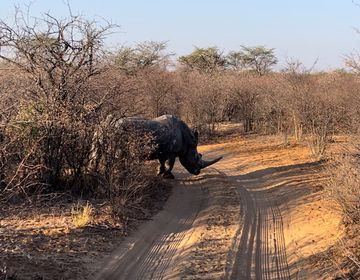NGO Day!
Hello, hello!
As promised, today was NGO day! We divided into three groups and visited the Kalahari Conservation Society, Birdlife Botswana, and Leopard Ecology and Conservation. Kalahari Conservation Society is an organization that researches desertification issues in Botswana. They help on sand-dune reclamation projects, and management plans for protected areas, and they also assist in transboundary park initiatives. Another large topic (for all the NGOs) is education. Most conservation-based organizations see the value in educating the public/local communities and thus helping many species and ecosystems. Going along with this theme of aiding through education, Birdlife Botswana does just that. Students who headed to this organization met with the director of Birdlife Botswana, as well as several other staff members, who were eager to share with us. BirdLife Botswana has four pillars: sites, species, empowering people, and ecological sustainability. A big species they focus on is the vulture (throwback to the last blog, remember these are an endangered species!). They also shared how funding continues to be difficult, for example, many people and organizations will donate to an elephant, and while that is indeed spectacular, fewer people are enthused to donate to a vulture. However, they continue to advocate for these, and many other birds. The last organization students visited was Leopard Ecology and Conservation. This organization is fairly new in the grand scheme of things, founded in 2000. The goal was originally to study exclusively leopards (as the name alludes to), but they realized quickly that lions needed their help as well. Now, their three pillars are leopards, lions, and humans. Their goal is to mitigate the conflicts between these cats and humans and ensure the long-term survival of the leopards and lions.
Students came back, and in addition to making presentations on what they learned today at the NGOs, they presented their poster projects. Over the last couple days, the students have been researching the ranges of an animal of their choice from Botswana. The posters turned out great, and the Navigators crushed their presentations. They all have become mini-experts in the animals they picked. Originally, we were to bring all of the posters to the SOS village we will be visiting later this week, however, the posters caught the eye of some of the staff at Mokolodi. We will be leaving four posters behind, so that Mokolodi can use them to help educate the children that come through. We program leaders, of course, were very proud of our Navigators and the effort they put into research and these posters.
Tomorrow, we will be making our way to the Khama Rhino Sanctuary and then the Okavango Delta. While I can promise you that we will come back with photos that will knock your socks off, they may be a little bit delayed. The Internet isn’t a guarantee up there. However, I do promise to fill y’all in when I can! As always, stay tuned.
Related Posts
Final Reflections and Advice for Future Students
It is our last day here in Botswana and before all the tears began, we asked students to share some of their final reflections and thoughts. Over the past three... keep reading
A Baobab that rose from the Okavango Delta
There are some things that are iconic to the continent of Africa- the big five, delicious food and the majestic Baobab tree. The Baobab is known as the tree of... keep reading
Khama Rhino Sanctuary
The first stop on our journey to the northern part of Botswana was the Khama Rhino Sanctuary; established in 1992, the sanctuary is a “community based wildlife project” aimed at... keep reading









